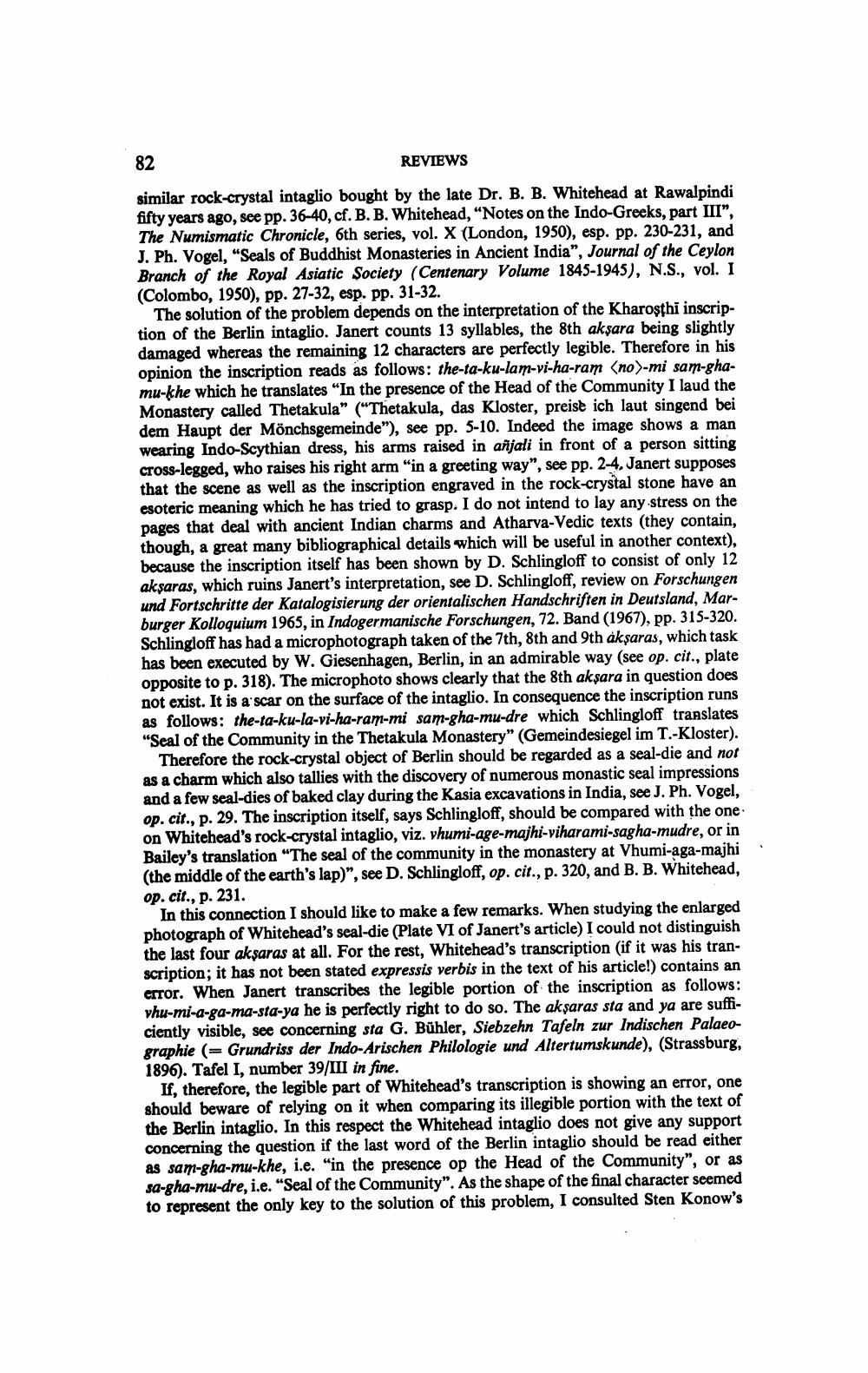Book Title: Reviews Of Different Books Author(s): Publisher: View full book textPage 6
________________ 82 REVIEWS similar rock-crystal intaglio bought by the late Dr. B. B. Whitehead at Rawalpindi fifty years ago, see pp. 36-40, cf.B.B. Whitehead, "Notes on the Indo-Greeks, par The Numismatic Chronicle, 6th series, vol. X (London, 1950), esp. pp. 230-231, and J. Ph. Vogel, "Seals of Buddhist Monasteries in Ancient India", Journal of the Ceylon Branch of the Royal Asiatic Society (Centenary Volume 1845-1945), N.S., vol. I (Colombo, 1950), pp. 27-32, esp. pp. 31-32. The solution of the problem depends on the interpretation of the Kharosthi inscription of the Berlin intaglio. Janert counts 13 syllables, the 8th aksara being slightly damaged whereas the remaining 12 characters are perfectly legible. Therefore in his opinion the inscription reads as follows: the-ta-ku-lam-vi-ha-ram <no)-mi sam-ghamu-khe which he translates "In the presence of the Head of the Community I laud the Monastery called Thetakula" ("Thetakula, das Kloster, preise ich laut singend bei dem Haupt der Monchsgemeinde"), see pp. 5-10. Indeed the image shows a man wearing Indo-Scythian dress, his arms raised in anjali in front of a person sitting cross-legged, who raises his right arm "in a greeting way", see pp. 2-4. Janert supposes that the scene as well as the inscription engraved in the rock-crystal stone have an esoteric meaning which he has tried to grasp. I do not intend to lay any stress on the pages that deal with ancient Indian charms and Atharva-Vedic texts (they contain, though, a great many bibliographical details which will be useful in another context), because the inscription itself has been shown by D. Schlingloff to consist of only 12 aksaras, which ruins Janert's interpretation, see D. Schlingloff, review on Forschungen und Fortschritte der Katalogisierung der orientalischen Handschriften in Deutsland, Marburger Kolloquium 1965, in Indogermanische Forschungen, 72. Band (1967), pp. 315-320. Schlingloff has had a microphotograph taken of the 7th, 8th and 9th aksaras, which task has been executed by W. Giesenhagen, Berlin, in an admirable way (see op. cit., plate opposite to p. 318). The microphoto shows clearly that the 8th aksara in question does not exist. It is a scar on the surface of the intaglio. In consequence the inscription runs as follows: the-ta-ku-la-vi-ha-ram-mi sam-gha-mu-dre which Schlingloff translates "Seal of the Community in the Thetakula Monastery" (Gemeindesiegel im T.-Kloster). Therefore the rock-crystal object of Berlin should be regarded as a seal die and not as a charm which also tallies with the discovery of numerous monastic seal impressions and a few seal-dies of baked clay during the Kasia excavations in India, see J. Ph. Vogel, op. cit., p. 29. The inscription itself, says Schlingloff, should be compared with the one on Whitehead's rock-crystal intaglio, viz. vhumi-age-majhi-viharami-sagha-mudre, or in Bailey's translation "The seal of the community in the monastery at Vhumi-aga-majhi (the middle of the earth's lap)", see D. Schlingloff, op. cit., p. 320, and B. B. Whitehead, op. cit., p. 231. In this connection I should like to make a few remarks. When studying the enlarged photograph of Whitehead's seal-die (Plate VI of Janert's article) I could not distinguish the last four aksaras at all. For the rest, Whitehead's transcription (if it was his transcription; it has not been stated expressis verbis in the text of his article!) contains an crror. When Janert transcribes the legible portion of the inscription as follows: vhu-mi-a-ga-ma-sta-ya he is perfectly right to do so. The aksaras sta and ya are sufficiently visible, see concerning sta G. Buhler, Siebzehn Tafeln zur Indischen Palaeographie (= Grundriss der Indo-Arischen Philologie und Altertumskunde), (Strassburg, 1896). Tafel I, number 39/III in fine. If, therefore, the legible part of Whitehead's transcription is showing an error, one should beware of relying on it when comparing its illegible portion with the text of the Berlin intaglio. In this respect the Whitehead intaglio does not give any support concerning the question if the last word of the Berlin intaglio should be read either as sam-gha-mu-khe, i.e. "in the presence op the Head of the Community", or as sa-gha-mu-dre, i.e. "Seal of the Community". As the shape of the final character seemed to represent the only key to the solution of this problem, I consulted Sten Konow'sPage Navigation
1 ... 4 5 6 7 8 9 10 11 12 13 14 15 16 17 18
